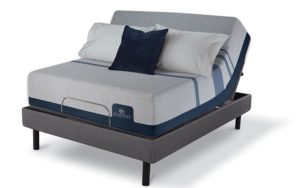Memory foam is a viscoelastic polyurethane foam found in many bedding-related products. Invented in 1966 by NASA to improve aircraft cushions and then adapted for public use in 1991, memory foam is now used in mattresses, pillows, and bed toppers. Memory foam mattresses are commonly known for their cradling, body-hugging feeling and are one of the most popular mattresses sold today.
Memory foam actively molds to your body in response to heat and pressure, evenly distributing your body weight into the mattress. The mattress returns to its original shape once pressure from your body is removed.
This feature provides health benefits like uniform body support, alignment of the curvature of your spine, alleviation of joint and back pain, pressure point relief, and motion isolation.
A memory foam mattress is denser and more supportive than the average polyurethane foam mattress. As you can guess from its name, it cradles and remembers your body shape then slowly goes back to its original form after you leave the bed. It is also hypoallergenic because it prevents allergy-causing dust mites and other allergens from collecting within the bed.
These are the basic features of memory foam mattresses but there are many other variables to consider to help you choose the best memory foam mattress for you.
Types of Foam Mattresses
There are many mattresses to choose from and not every mattress is right for every person. Sleep needs and preferences vary so it is important to research which is the best type of mattress to fit your health concerns, lifestyle, sleep preference, and budget.
Let’s briefly overview the different types of foam mattresses to help you decide how to choose a mattress that is best suited for you.
Polyurethane Foam
Polyurethane foam or poly-foam is the least expensive and lowest-quality foam used in mattresses and mattress toppers. You may know polyurethane foam as the type of foam used in couch cushions or cheaper “egg crate” mattress toppers. Polyurethane foam is primarily comprised of compounds derived from petrochemicals.
Polyurethane foam provides some softness and support but it will not provide the same targeted support that memory foam or latex foam can. Polyurethane foam also will collapse much quicker when pressure is applied.
Traditional Memory Foam
Traditional memory foam actively responds to heat as it is temperature sensitive. In its early days, its heat-retaining property was a complaint from warmer sleepers but loved by those who sleep cold. In the 2000s, open-cell memory foam, gel memory foam, and other mineral-infused memory foam like copper, graphite or carbon were introduced.
Each option combats heat retention and helps regulate body temperature. This is an important feature to search for when you decide to buy a memory foam mattress.
Open-Cell Memory Foam
Open-cell memory foam is similar to traditional memory foam but has a different internal structure. This mattress type gets its name from internal pockets known as open cells. These cells allow for ventilation and airflow throughout the mattress, helping disperse heat and creating a cooling effect that traditional memory foam doesn’t provide.
Gel Memory Foam

Mineral-Infused Memory Foam
Some memory foam mattress makers have chosen to add natural minerals such as copper or graphite to their mattresses for the purpose of cooling. Copper is the second most conductive element in the world, and helps with both heat-dispersal and moisture-wicking when used in memory foam mattresses. Copper attracts heat like a magnet, pulling it away from your body to help neutralize your body temperature as you sleep.
Graphite is a form of crystalline carbon that is very soft and resistant to heat. The secret to graphite’s cooling success is its small spherical pores, which allow it to absorb heat better than other elements. To make graphite memory foam mattresses, graphite is either mixed directly into the foam or applied as a separate, thin layer on the top of the mattress. The sleeper’s weight pushes the graphite particles closer together, allowing them to conduct and dissipate heat quickly.
Mattress Express favorites include the IFS Chill Series, Puffy, the Wellsville Air Foam Gel Series and the Posh and Lavish Hybrid Collection.
Not sure which mattress is right for you?
Take our Express Comfort Quiz for instant recommendations.
Get Started!
Not sure which mattress is right for you?
Take our Express Comfort Quiz for instant recommendations.
Get Started!Latex Foam
Latex mattresses are one of the most durable and eco-friendly mattresses. The feel of a latex mattress is similar to a memory foam mattress, as it contours to your body. The material is cooler than memory foam, though, with an added bounce to it.
Latex is known as a buoyant material, which differs from traditional foam beds. When you lie on a latex bed, the mattress snaps back into place once you’re out of the bed.
Natural latex mattresses are made from rubber tree sap and go through a sustainable manufacturing process. There are two types of natural latex: Dunlop latex and Talalay latex. However, not all latex beds are made with raw materials.
Latex mattresses tend to be better long-term investments for sleepers since they last up to 20 years.
However, if you are not ready to make this long-term commitment or have a limited budget, latex beds have similar qualities to a memory foam bed. Both beds can enhance your sleep by offering excellent pressure-point relief and body-hugging comfort to cradle the sensitive parts of your body.
Check out the Posh and Lavish Latex line at Mattress Express.
Memory Foam Density
Like any material, the quality of memory foam can differ. An important feature to pay attention to is the density of the memory foam used to make your mattress. The density of memory foam used for mattresses can vary from one-pound density to five-pound density. A mattress made with three- to four-pound density or higher should last you over a decade. A one-pound density mattress could develop body impressions and need to be replaced as early as a year or two after purchasing. The lower-density foam mattresses may sell for a low price but that quality varies as well when comparing the long-term cost. You may want to spend a little more now to save money in the future.
Other Considerations
Heat

Natural latex foam is one of the most breathable mattress materials available. The gel memory foam, open cell memory foam, and mineral-infused memory foam also offset the heat-retaining properties of standard memory foam to give you a comfortable night of sleep.
Response Time
The response time of your memory foam mattress is measured by how quickly it bounces back to its original state. It is rated by a number of factors, such as the composition of the foam, changeable viscosity, the rate of elasticity, and resilience. The faster your mattress lets go of your body weight, the more pressure relief you will receive. Lower-quality memory foam may have a slower response time causing issues for older people or those with mobility issues.
Mattress Thickness
Although a standard mattress may be about eight inches, luxury mattresses tend to range from 10 to 18 inches due to the oversized support and comfort layers that make each mattress unique in design.
A 10-inch memory foam mattress tends to have a firmer feel while a 14-inch or larger memory foam mattress tends to have a plush feel.
Sleeping Positions
Side Sleepers
Sleeping on your side is the most common sleep position and is good for your long-term health. A plush memory foam mattress is perfect for side sleepers as they provide an extra layer of cushioning to protect shoulders, hips and ankles from discomfort.
Back Sleepers
Sleeping on your back is great for your health as your body weight is spread evenly across your mattress. The best memory foam mattress for a back sleeper should be a balance of support and comfort.
Stomach Sleepers
If you sleep on your stomach, it is best to buy memory foam that has a firmer feel to minimize the overarching of your spine.
Purchasing a Memory Foam
Now you know how to pick a mattress that is ideal for you, stop into any of our Mattress Express locations and one of our sleep specialists will point you in the right direction.
Be sure to ask about each mattress’s individual mattress warranties, what the delivery options are for your favorite choices, and the timeframe in which you can expect to have your mattress in your home.
Don’t forget to purchase a few new memory foam pillows of choice as well!

